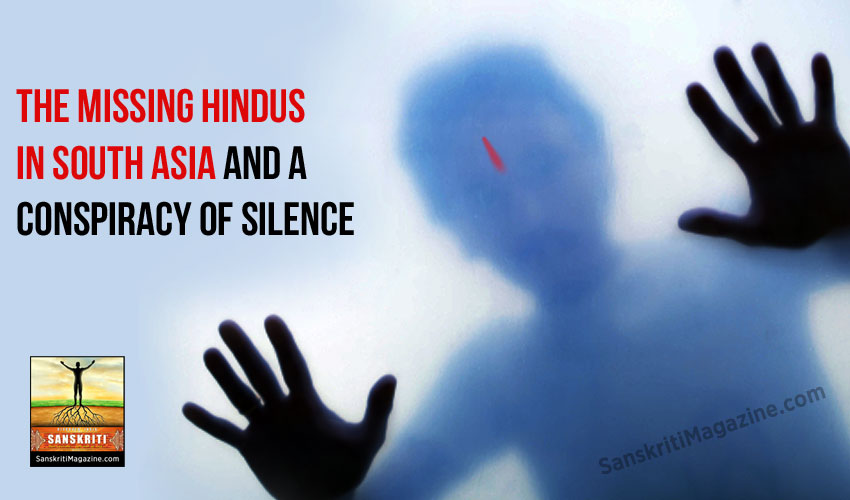Indian media has done a commendable job in covering international events, be it Arab Spring, Tahrir Square, Gaza conflicts to beatification of saints at Vatican. The only blind spot has been the plight, or rather the genocide, of Hindus worldwide, including our neighboring countries like Pakistan or Bangladesh. This is quite inexplicable given that other events in these nations that have been generously covered.
Genocide of Hindus in India’s Backyard
Let me first start with startling facts that should have by now been well known to an Indian audience in normal course. When Pakistan was created in 1947, Hindus constituted about 15 per cent of the population of West Pakistan (current Pakistan); by 1998 it is about 1.6 per cent (p. 76, Hindus in South Asia and the Diaspora: A Survey of Human Rights 2013) – the population has declined by about 90 per cent in about 50 years. This decimation is the outcome of sustained legal and social discrimination ever since the creation of Pakistan. On the legal front, only Muslims are eligible for the position of President or Prime minister of Pakistan. The Sharia court in Pakistan has promoted religiosity and strengthened fanatics. It inflicts Islamic punishments, including stoning to death, amputation of hands and feet, 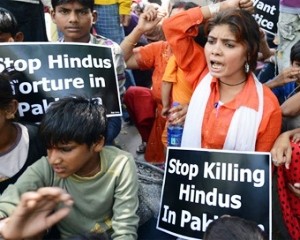 flogging in public to non-Muslim citizens too. Blasphemy laws carry a death sentence and have been used to target non Muslims. Family laws for non-Muslims do not exist. Thus, marriages can not be legally established for purpose of travel, and divorce and property right disputes can not be resolved. On the social front, curriculum in government schools and Madrasas promote religious hatred against minorities. The number of Madrasas has increased from 244 in 1956 to 10,000 in 2013 (p. 74) .
flogging in public to non-Muslim citizens too. Blasphemy laws carry a death sentence and have been used to target non Muslims. Family laws for non-Muslims do not exist. Thus, marriages can not be legally established for purpose of travel, and divorce and property right disputes can not be resolved. On the social front, curriculum in government schools and Madrasas promote religious hatred against minorities. The number of Madrasas has increased from 244 in 1956 to 10,000 in 2013 (p. 74) .
As a result, Hindu women, mostly minors, are being persistently abducted and forcibly converted, Hindu businessmen kidnapped for ransom, and Hindu temples destroyed. An elaborate infrastructure has been designed to prey upon the likes of Rachna Kumari and Rinkel Kumari. The human rights commission in Pakistan reports that 20-25 young Hindu girls are abducted and forcibly converted every month. Dawn puts this number at 1000 every year for Hindu and Christian women. Pakistan has been home to numerous Hindu temples of which only 360 remain, with an even smaller number functioning; thousands of temples have been destroyed since 1947 (p. 81). One of the holiest sites of the Hindus, the Hinglaj Mata Mandir has also been targeted by extremists. Bereft of any hope for dignified survival in Pakistan, Hindus are taking refuge abroad. Pakistan Hindu council estimates that about 5000 Hindus leave for India every year (p. 73).
The genocide of Hindus is not limited to Pakistan. Starting in the late 1980s, Buddhist Bhutan has expelled nearly 100,000 traditional Hindus, constituting about 1/6th of Bhutanese population. From almost a third of East Pakistan’s (currently Bangladesh’s) population as per Pakistan’s 1951 census, by 1971, when Bangladesh was born out of East Pakistan, Hindus were less than a fifth of its population; Hindus constitute less than 10 per cent of the populace there thirty years later; and as little as 8 per cent today per reliable estimate (R Benkins A Quiet Case of Ethnic Cleansing – The Murder of Bangladesh’s Hindus). The situation is now so dire that even Amnesty has taken note that the Hindu community in Bangladesh is at extreme risk and is being targeted simply for their religion (p. 24). In 1971 alone 10 million ethnic Bengalis, mostly Hindus fled to India and 200,000 women were raped (p. 26). From 1975 onwards, religious minorities including Hindus have been subjected to discriminatory property laws, restrictions on religious freedom and violence perpetrated by both state and non-state agencies (p. 30). For example, Hindus are attacked almost every year during the celebration of their most important festival, Durga Puja. Before creation of Bangladesh Pakistani government had instituted an enemy property act (EPA) in 1965, which officially labeled Hindus as enemies and enabled annexation of their properties. The EPA has continued under different names since the creation of Pakistan: VPA (Vested Property Act), VRPB (Vested Property Return Bill) etc, and has robbed 200,000 Hindu families of 16 X 107 square meters of their land between 2001 to 2007 (estimated by Abul Barakat of Dhaka University) (p. 43). Similarly, the Bumiputra policies explicitly discriminate against 6.3 per cent Hindus in the Islamic republic of Malyasia (p. iv).
The only thing necessary for the triumph of evil is that good men should do nothing. ~ Edmund Burke
Government of India
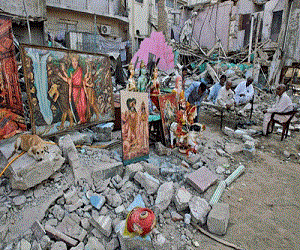
Civil society, media and the government of India have all remained mute spectators while this human tragedy of unimaginable magnitude has been unfolding right in their backyard. Indian government has not accorded the official status of refugees to Hindus from Pakistan, despite satisfying the criteria for refugee status under international law due to Pakistan’s failure to protect them from religious persecution. They live in abject poverty, in cramped and squalid conditions in open tents in North and North West India, and have been suffering from repeated colds, coughs, psychosomatic conditions, blindness and oral tumors. This apathy has continued under governments of all political hues. It has however been reported that the current government lead by Prime Minister Modi is planning a package which includes private jobs and a fast track process for Indian citizenship for Hindu and Sikh refugees from Pakistan. The state government of Madhya Pradesh lead by Chief Minister Shivraj Singh Chouhan has rehabilitated 5464 minority refugees from Bangladesh. No government of India has however discussed the religious persecution of Hindus in neighboring countries in any internal or external forum. In contrast, Pakistan has raised Gujarat riots at United Nations.
The apathy of governments regardless of their political hues has perhaps resulted from the distortion introduced in classical notions of secularism by the Indian polity. Secularism has traditionally been defined as the separation of governance from religion – in India it instead accords special legal and financial privileges to practitioners of all religions other than Hinduism, and celebrates historical figures like Aurangzeb who have followed a persistent policy of religious persecution (all governments till date have refused to rename a road named in his honour).
Although, unlike India, Hindus constitute a small fraction of US population, public representatives in US have started taking cognizance of the plight of minorities in India’s neighborhood. Fifteen members of Congress had submitted a bipartisan letter to then Secretary of State, Hilary Clinton urging her to ensure that religious persecution of minorities end in Pakistan. Democrat Congresswoman Tulsi Gabbard (Hawaii) and republican Congressman Aaron Schock (Illinois) have spearheaded a bipartisan Congressional letter that urges US Secretary of State John Kerry to make human rights of the minorities in Bangladesh a priority in bilateral relations with US. Arlene A Juracek, the mayor of the village of Mount Prospect has recognised the tragedy of Hindus in Bangladesh who can not celebrate Durga Puja in Bangladesh owing to its anti-Hindu laws.
The vibrant and ever watchful civil society in India has turned a blind eye to this gargantuan human tragedy. This is astonishing given that many activists are vigilant about caste violence perpetrated against the traditionally disadvantaged classes, as they should be. Yet, the cause of Hindus in India’s backyard, as also their plight as refugees in India, has not been championed despite the fact that they are predominantly Dalits. Protests against their persecution have been few and far between, and mostly relegated to much reviled supposedly casteist right wing Hindu groups. Protests have meanwhile been organised in Washington DC. Civil rights advocacy for Hindus is being spearheaded by an organization based in US (Hindu American Foundations) but not by civil rights groups in the country that is home to the largest number of Hindus anywhere in the world (Read [1], [8],[11], [15], [16]). It is worthwhile mentioning that the outrage in civil society on the ethnic cleansing of Kashmiri Pandits from the Indian state of Jammu and Kashmir has been substantially muted as compared to that on Gujarat riots. Yet, the latter does not compare in scale to the size of the affected population for genocides in Kashmir (neither in Pakistan, Bangladesh, Bhutan for that matter). From about 7 per cent of the overall population in Kashmir in 1901 (p. 30, 38), 4-5 per cent in 1981, (p. 38, Students Academy: Kashmir – A paradise on the Earth, p. 255, Rahul Pandita, “Our Moon has Blood clots: The Exodus of Kashmiri Pandits’’), Pandits reduced to a meager 808 families comprising of 3445 members in 2010 per government report. As per figures given by UPA minister Shriprakash Jaiswal in a written reply in Parliament on May 11, 2005, 790 Muslims and 254 Hindus were killed in the riots, 2548 people were injured and 223 people were missing.
The most unkindest cut of all
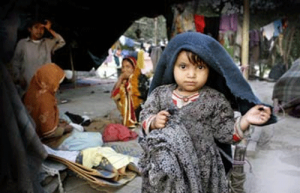
The Indian media was expected to remain vigilant on the status of minorities in India’s neighborhood, given how Hindus and Sikhs were butchered in Pakistan at its nascence (Bangladesh was then part of Pakistan). Jinnah had written in a letter to the governor general that Sikhs will need to leave Pakistan (p. 175, Muslim league attack – Sikhs and Hindus in the Punjab 1947). Well known Muslim league leader, Zafar Ali Khan, the proprietor of Daily Zamindar of Lahore, urged in his newspaper on September 5, 1947 that no Sikh be allowed to remain in West Punjab (p. 137, Muslim league attack – Sikhs and Hindus in the Punjab 1947), and they left. Seven million Hindus and Sikhs were forced to leave Pakistan because of the organised mass slaughters. In Sheikhupura, the district that contains Nankana Sahib, the birth place of Guru Nanak, in 2 days, 10,000 – 20,000 were killed in cold blood in 1947 (p. 167, Muslim league attack – Sikhs and Hindus in the Punjab 1947). All Hindus in Rohtas and Sanghoi of Jhelum were put to death (p. 200, Muslim league attack – Sikhs and Hindus in the Punjab 1947 ). In 128 villages of Rawalpindi district, 7000 Hindus and Sikhs were killed, and 1000 women were abducted in matter of days in March 1947, as per news reports (the actual number is likely to be higher). Owing to these atrocities, perhaps, Nehru, not remotely communal by any standards, had said that the deeds in the Rawalpindi division would shame even beasts (p. 90, Muslim league attack – Sikhs and Hindus in the Punjab 1947).
Around the time of its creation, Pakistan government had also commissioned a team of Maulavis to convert young abducted women as per a civil and military gazette report in 1947. Hindu Sikh refugees who could flee to India had given statements that while men were only forcibly converted, women were forcibly married in addition. Hindu and Sikh girls brought by Pathan raiders of Kashmir were sold in the bazaars of Jhelum district. Hindu and Sikh women immolated themselves to escape tortures the mobs were subjecting them to – 1) chopping of breasts, noses, arms, 2) insertion of sticks and pieces of iron in their private parts, 3) ripping open wombs of pregnant women and throwing off the fetus. Even children were not spared – snatched from their parents, they were tossed on spears and swords and some times burnt alive (Muslim league attack – Sikhs and Hindus in the Punjab 1947).
Similarly, in Noakhali in then East Pakistan, in an elaborately planned carnage launched on October 10, 1946, on Kojagari Lokkhi Purnima, one of the holiest days of Bengali Hindus, the hinterland of Noakhali was cut off from the town by breaking the bamboo bridges across the canals. The boatmen, who were all Muslims, refused to ply Hindus across, and Muslim league volunteers guarded all routes leading to railway stations (pp. 104-105, first edition, Tathagata Roy My people uprooted: A saga of the Hindus of eastern Bengal). A mayhem of targeted murder, rape and forcible conversation ensued. Cabinet minister Arthur Henderson reported to the house of commons on Nov 4, 1946 that at least 9895 Hindus were forcibly converted to Islam (likely many more) and thousands of Hindu women were abducted and married to Muslims against their will, stone idols were smashed and Hindu temples desecrated and Hindu men were forced to slaughter their own cows and forced to eat beef (p. 109, first edition, Tathagata Roy My people uprooted: A saga of the Hindus of eastern Bengal). Dr Shyamaprasad Mookerjee, who would later become a cabinet minister in India, wrote that 50,000 – 75,000 Hindus have had to flee their homes to escape the brutalities and live as destitutes for a while (pp. 110-112, first edition Tathagata Roy My people uprooted: A saga of the Hindus of eastern Bengal).
It would therefore be reasonably feared that Pakistan and later Bangladesh would not ensure the safety of its minority citizens. It is therefore inexplicable that Indian media would remain largely oblivious of the genocide of Hindus that did follow. To my knowledge, India Today did a cover story on Hindus in Pakistan in the wake of the abduction of Rinkle Kumari on February 24, 2012. The tragedy of this young woman has received some coverage in other Indian news sites as well ( [4], [23] [24]). But, a systematic study of the genocide in Pakistan has been missing by and large; sporadic reports have focused on conditions of Pakistani Hindu refugees in India. A web search reveals that most of the limited coverage (outside Pakistan) that this human tragedy has received has been in news sites outside India. The story is no different for Hindus in Bangladesh, Bhutan or Malyasia either.
Yet, sites with much less resource than major media sites in India has started delving deeper. India Facts will be publishing monthly reports on human rights abuse of Hindus in Pakistan – the first has already appeared. Swarajya Magazine has published substantive research enumerating the discriminatory laws in Pakistan. Hindu American Foundations has published extensive documentations of religious persecution of Hindus all over the world. The apathy of Indian media about Hindu victims of persecution has therefore not been induced by the lack of resources.
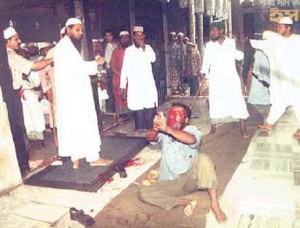
To the best of my knowledge, there are only three books in English on the genocide of Hindus in Bangladesh, R Benkins A Quiet Case of Ethnic Cleansing – The Murder of Bangladesh’s Hindus, Tathagata Roy A Suppressed Chapter in History: The Exodus of Hindus from East Pakistan and Bangladesh 1947-2006 and Garry Bass The Blood Telegram (only one of these is by an Indian); one on the genocide of Kashmiri Pandits (its written by a Kashmiri Pandit); none on that in Pakistan or elsewhere. This stands in stark contrast to the extensive research directed on the Jewish holocaust and Gujarat riot (to name a few, Parvis Ghassem Fassandi Pogrom in Gujarat: Hindu Nationalism and Anti-Muslim Violence in India, Michael Mann The Dark Side of Democracy: Explaining Ethnic Cleansing). It is pertinent to note that journalist Swapan Dasgupta, who has reviewed the only book written on the genocide of Hindus in Bangladesh by an Indian author (Tathagata Roy A Suppressed Chapter in History: The Exodus of Hindus from East Pakistan and Bangladesh 1947-2006) has mentioned in a twitter conversation that there has been limited interest in even reviewing the book, notwithstanding its historical value. It is perhaps legitimate to ask of the Indian media and its civil rights activists why has the extent of their vigil not depended on the magnitude of a human tragedy rather than on the religion of the victims?Religious bias in media reporting?
Rather than alleging Hindu phobia in Indian media, I would conclude by placing a few incontrovertible facts pertaining to the difference in the nature of the coverage based on the religion of the victims.
1) Indian media extensively covered the murder of a Muslim techie by Hindu goons in Pune, but barely mentioned brutal killings of a RSS pracharak in Kerala and a BJP secretary in Tamil Nadu or the rape of a 9 year old Hindu girl by a Muslim. It regularly champions the causes of under-trial Muslims at times accused of terror, but not of a Hindu woman Sadhvi Pragya who was arrested for involvement in Malegaon blasts and incarcerated for five years without charges being filed. No feminist or human rights group has come to her aid though she has alleged torture and harassment and has been deniedbail despite her cancer diagnosis. Similarly, army intelligence officer Lt Col Purohit has been incarcerated six years, again, without trial. He has alleged brutal torture lasting for several days. It is worth noting that the previous home minister Sushilkumar Shinde had asked all chief ministers to ensure that no Muslim be wrongfully held on charges of terror, notwithstanding the fact that the emphasis on religion is inconsistent with the principle of secularism as has been classically defined. As practicing Hindus, neither Sadhvi Pragya nor Colonel Purohit can avail of the Muslim specific leniency provisions that Shinde instructed the chief ministers to institute.
2) Gujarat riots have been reported on extensively in the national media for a decade, but religious violence Hindus have been subjected to in border districts of Bengal have been mostly ignored or barely received a mention in the national and Bengali media. Indian army had to be deployed to quell the arson and violence perpetrated by Muslim mobs against the local Hindu community in De Ganga. Muslim mobs burnt down 200 Hindu homes in Canning police station area. Islamic organisations conducted a rally in Kolkata in support of a vocal anti-India preacher, a rabid anti-Hindu who has organised pogroms against Hindus in Bangladesh. Lakhs of extremist Muslims engaged in mass violence in the streets of Kolkata protesting the investigation of cross border terror. Hindus have been denied cremationrights in currently Muslim majority Murshidabad. A Hindu activist organisation has been painstakingly documenting instances of religious persecution of young Hindu women in this region – no main stream journalist has followed up or likely even verified their research (I had personally drawn the attention of several journalists towards their reports). Not only Bengal, as discussed later, national media has looked the other way on the persecution of Hindus in North East India too.
3) Usually victims of marital persecution are given a sympathetic hearing in Indian media; but national level shooter Tara Sahdeo was harshly grilled in several television channels when she alleged that her husband tortured her demanding that she converts to Islam. In fact, most Hindu women who have alleged attempts to convert them in the guise of a relationship have been reviled in Indian media. Not surprising then that the call of Imam Bukhari of Jama Masjid urging Muslim youth to marry Hindu women for converting them has hardly been mentioned.
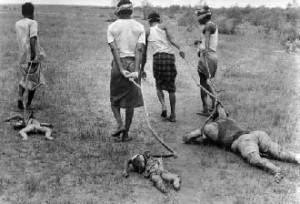
4) Indian media was outraged when a Hindu activist, Dina Nath Batra, slapped a civil suit against Wendy Doniger’s book on Hinduism and had the publisher withdraw all copies of the book. It is worth noting that Mr. Batra attained his end through constitutional means, and not by inciting public violence. Yet, the same media has remained largely silent when author Tasleema Nasreen who happened to offend Muslim fundamentalists through her criticisms of Islam was forced to move from Calcutta due to violent protests by Muslim mobs. She has been subjected to physical violence for her views by MIM leaders, and the assault has been publicly defended by Akbaruddin Owaisi, the brother of the president of MIM. TV serials and movies associated with author Tasleema Nasreen have routinely been banned in West Bengal even when they were unrelated to her views on Islam. Indian media has failed to compellingly defend her freedom of expression in each of those instances.
5) There has been a furore in Indian media and in Parliament on one instance of conversion of Muslims and Christians to Hinduism. Neither has however agitated on predatory proselytising and at times forcible conversions enabled by millions of dollars of foreign grants (missionaryorganisations pushed more than 250 million dollars to India in one year). English language media has condoned the state patronage extended to Christianity by the late Y S Rajasekhara Reddy, the former Chief Minister of Andhra Pradesh, through its elegant silence. Even worse, national media which highlights Hindu fringe on every conceivable opportunity has remained silent on a violent Christian fringe which has sought to forcibly convert Hindus to Christianity in the North East. Dayanath singh, Gujarat press club office secretary, has reported that in Bhuvan Pahar, one of the most holy places in Barak valley of Assam, a Christian militant organisation, namely, Manmasi National Christian Army (MNCA), has been forcing at gun point the Hindu residents, including priests, to convert to Christianity. Footages of blood stained crosses drawn on hindu Temples also exist. Tripura state government contends that the Baptist Church of Tripura supplies arms and gives financial support to the separatist group National Liberation Front of Tripura, NLFT, which has among its stated goals the conversion of all Hindu tribes in Tripura to Christianity. NLFT has banned Hindu festivities like Durga Puja, killed over 20 Hindus from 1999 to 2001 for resisting forced conversion to Christianity, forcibly converted tribals using “rape as a means of intimidation’’(Adam, de Cordier, Titeca, and Vlassenroot (2007) In the Name of the Father? Christian Militantism in Tripura, Northern Uganda, and Ambon. Studies in Conflict and Terrorism ), broken into a temple and gunned down a popular Hindu preacher known as Shanti Kali. It is telling that my references for the terror allegedly fomented by the church in India’s North East have been BBC, and not Indian media reports.
Conclusion
Any dent in the credibility of the fourth estate in any country bodes ill for the democracy therein as this organ of our polity is expected to serve as a watchdog of our society. It is therefore hoped that Indian media in particular, and Indian public discourse in general, would introspect so as to mitigate the case of bias against Hinduism that may well stand against them today.
~ Saswati Sarkar, Feminist, agnostic, politically bipartisan, Indian, Bengali, socially progressive, follows Hindu human & legal rights, student of Hindu history and engineering arcade.

